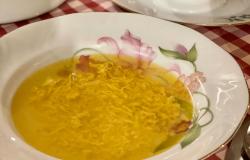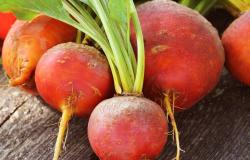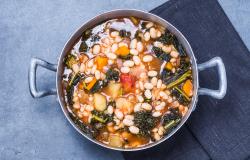“Pancake” Pasta with Marjoram Pesto (Testaroli)
I had no clue what to make of the 18-inch giant spongy pancake I spotted in a gourmet shop in Liguria. It was shrink-wrapped, rolled like a diploma, and tied with pretty green ribbon. When the shopkeeper explained that it was “pasta,” meant to be boiled, I was dubious. I mean, who would boil a pancake? Turns out, the Italians have been doing it since at least the 1300s, and perhaps even back in ancient Roman times.
The name of this pasta, testaroli, derives from testo, the special terracotta pan these pancakes are cooked in, but, of course, you can make them in a cast-iron skillet or other pans as well. The dough is simple to work with, more like crepe pancake batter than pasta dough. In Italy, they combine all kinds of flours with half white flour to make the batter—whole wheat, fine corn flour, buckwheat, farro, and chestnut flours—so here’s a good chance to try a new flour you’ve been wanting to experiment with.
This is a great make-ahead dish as the pasta pancakes are best after they’ve rested for at least 24 hours and will stay fresh for a week before boiling. It’s delicious with this aromatic marjoram pesto, but also wonderful with any sauce.
Serves 4
For the pasta:
Combine the flours in a large bowl. Add the olive oil, salt, and slowly stir in 2 cups of water to get a thin, smooth batter, like crepe batter. Let rest at room temperature for 10 minutes.
Heat a large nonstick frying pan, cast-iron skillet, or crepe pan until hot. Dip the onion half into some olive oil and rub onto the pan, using the onion to grease the pan and flavor the oil a bit. Add just enough batter to the pan to create a thin layer, spreading the batter quickly by tilting the pan, just as you would when making crepes. Cook on medium until the edges come up a bit and you can easily turn the pancake over, about 7 to 10 minutes. Turn and cook on the other side for about 5 minutes. Repeat, remoistening the pan with the oil-dipped onion until all the batter is used. Once the pancakes cool, store in a sealed airtight container in a cool place at least 12 hours before cooking or they will be gummy.
To cook the pancakes, cut them into roughly 1 x 3 1/2 inch rectangles or triangles. Bring a pot of salted water to a boil, add the pancake pieces, and immediately turn off the heat. Leave them in the water for 2 to 3 minutes, until tender. Drain.
For the pesto:
In a mortar and pestle or in a small food processor, grind the pine nuts with at least 3 rounded tablespoons of the marjoram leaves stripped from the sprigs and a pinch of salt until smooth. Drizzle in the olive oil, very slowly, and grind until the pesto is very creamy. Stir in the cheese, taste, and add more marjoram or oil, if needed.
Top the drained pasta with pesto, a drizzle of olive oil, and garnish with sprigs of fresh marjoram.





